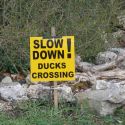Down in the morning to meet up with Donna and Darryl. The Opera Hotel (odd ring to "going to the opera in the morning") has been done up fairly nicely, clean, light, and a sea theme, and, best of all, looking out at St Lazarus. Coffee in the little breakfast room and then we decide to take the eleven o'clock bus to Nicosia. Collect maps at the tourist centre and round the corner to the water front for the Lefkosia (Nicosia) bus. It takes an hour, but gives us a look at the Cypriot countryside, green after the winter rains. Half of the hour is negotiating the Nicosia suburbs. Interesting to note that the bus now stops first at Ikea and the General Hospital. Potentially handy, though in the case of the latter one hopes not.
Walk over the border at the Ledra Street pedestrian crossing, Ledra Street on both sides being a pedestrian shopping area. Still, despite the shops, there's a distinct cultural change on crossing. Fewer, and less upscale shops, and more for sale on the street outside the shops. Start with the Buyyuk Khan, built in 1572 after the Ottoman takeover of the island. Initially a caravanserai, with two levels of rooms built around a courtyard, used after the British came in the 1870's as a prison, and eventually restored in the 1990's. Now all craft shops, with the courtyard used as a restaurant. A happy transformation, if a bit overpriced. We eat at the square opposite, having first persuaded the young man to move our table into the sun. It's only just warm enough - and for Darryl, stoical but in shirtsleeves - probably not. Would be OK, except for the wind. Nice leisurely lunch with salad, hummus, and yoghurt, as well as the typical Cypriot grilled meats and Efes beer at admirable North Cypriot prices.
Then to the Ömeriye Mosque, which was originally a Latin rite church, transformed by the Ottomans into a mosque. They're quite happy about "appropriately" clad visitors going in, so I take off my shoes, put on my headscarf, and take a look. Have been there before, but not for years. It's as simple and bare as most mosques, with, of course, its original soaring ecclesiastical architecture. The market next to it has been changed since our last visit, with much less fruit and veg than when we were there in the past and much more crafts and souvenirs and clothing. No butchers or nut sellers. Not really a farmers' market at all any more. Last stop is the Buyuk Hammam. Built in the early 14th century as the Latin Church of St George (some dispute over this) and transformed in the late 16th century into a Turkish bath. A sign on the hammam gives the schedule - times for men, women, and "tourist mixed". Makes us sound quite decadent. But regardless of schedule it is closed and padlocked. Then back across the border, past the signs warning that if we are going to claim refugee status we must do so immediately or face dire consequences, passports scanned, and we catch the 4:30 bus back.


